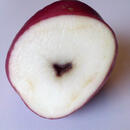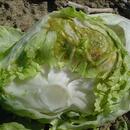All

Black heart is a quality problem that affects potatoes when they are deprived of oxygen. High temperatures and excess water in the soil contribute to this condition in the field. Potatoes can also develop this problem in transit or storage if they are exposed to very hot or very cold temperatures.
Bloom drop, or as it’s sometimes called—blossom drop, is when the bloom or flower of a vine crop (cucumbers, melons, gourds, and tomatoes to name a few) drops off, preventing the plant from producing fruit. Once the flower is pollinated, the plant grows a cucumber or tomato (or whatever type of plant it is) in that location. If the bloom falls off, nothing can grow.
The most frequent cause of this problem is inclement growing conditions (extreme hot or cold temperatures, high winds, or torrential rainfall). Commercial growers work on very set schedules, so when freezing temperatures cause the majority of a crop to experience bloom drop, the entire harvest is delayed until new flowers appear and new fruit has time to mature. This often creates a future supply gap and drives up market prices.
For more information about bloom (or blossom) drop, see Purdue and University of Florida.

Caused by the fungus Rhizoctonia solani, bottom rot is identified by sunken, reddish-brown spots on the bottom of plants, most notably, lettuces. If the fungus only affects the outer leaves they can be trimmed, but if it has invaded whole heads, they cannot be used. The spots most typically occur when leaves touch soil that contains the fungus and when temperatures are high and air is humid.

Bracketing is a cosmetic defect caused by inconsistent growth in broccoli plants. It typically occurs when there are large swings in temperatures, resulting in growth being stopped then started rapidly. The biggest problem caused by bracketing is that it prevents crowns from being trimmed to a short- or Asian-cut crown length. If the crown were to be cut, the florets would fall off the stalk.
The Brix scale was named for a 19th century German named A.F.W. Brix. This system is used in the United States to measure the sugar content in fruit, most notably citrus, grapes, and melons.
